Welcome to our weekly 'Ask a Vet from the SF SPCA' feature on 7x7.com. Dr. Jeannine Berger, DVM, DACVB is a board certified veterinary behaviorist who counsels guardians whose pets’ issues are beyond the scope of training. Think of her as a pet shrink…at your service. Ask your own questions in the comments!
Q: Thank you for your information last week about how to teach cats to use scratching posts. I find it very confusing to choose the right post. Do you have any suggestions?
A: The first thing to consider when buying a scratching post or furniture is whether or not your cat prefers angled, vertical or horizontal surfaces. Some cats like to stretch and pull down, while others like to stretch out horizontally along the floor. Most commercially available cat trees provide both surfaces–a base for vertical and a post for horizontal scratching, but the base might be too small for stretching out, and the post might be too short or not sturdy enough for the cat. Cardboard types tend to lie directly on the floor or at an angle, while other vertical scratching surfaces can be hung from a doorknob. The best thing you can do for your cat is to offer a few different options at first, observe your cat, and pick one based on your cat's personal preferrence
Material:
• Sisal rope scratching posts and cat furniture provide long-lasting scratching surfaces for cats. Sisal is very tough and resists shredding very well. Sisal scratching posts are excellent choices for cats who prefer to claw and scratch rough surfaces. The main downside to sisal is that it is not very easy to incorporate catnip into it to make it more attractive to your cat.
• Carpeted scratching posts and cat furniture make up the bulk of most manufactured scratching posts and furniture. It is easily made, easy to work with and can be attached to many different surfaces and shapes. It is also much easier to use to make larger cat trees. Carpet is not nearly as durable as sisal, so over time it shreds. Carpet also retains dirt and debris, so it will need occasional vacuuming and replacing.
• Cardboard scratching surfaces are fairly new and by far the cheapest alternative. Most cardboard scratching surfaces are refillable. Cardboard, which has a lot of holes, can easily accommodate catnip to make it more attractive; however, it shreds easily, leading to bits of cardboard getting spread everywhere. Some cats also like to chew on cardboard, which is not good, due to the chemicals present in cardboard.
• Wood is another type of scratching surface. These types are not very common but are probably the closest thing to what a cat in the wild would use to stretch, mark and shed on. A wood post will be very durable–more so than sisal. It does not lend itself to hosting catnip, but it also will not retain dirt or leave bits of itself lying around.





















